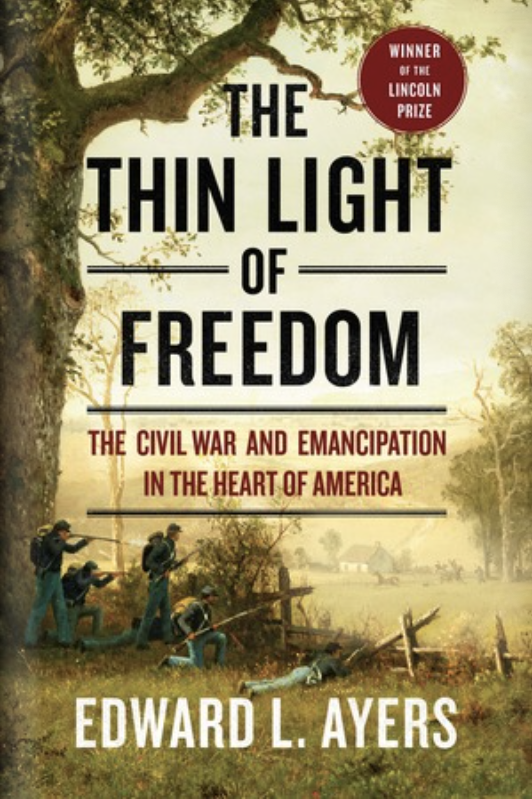The Thin Light of Freedom:
The Civil War and Emancipation in the Heart of America
Winner of the Lincoln Prize, 2018.
Winner of the Avery O. Craven Award, 2018.
At the crux of America’s history stand two astounding events: the immediate and complete destruction of the most powerful system of slavery in the modern world, followed by a political reconstruction in which new constitutions established the fundamental rights of citizens for formerly enslaved people. Few people living in 1860 would have dared imagine either event, and yet, in retrospect, both seem to have been inevitable. This book — the long-awaited conclusion to the Bancroft Prize- and Beveridge Award-winning In the Presence of Mine Enemies — tells that story.
Recent appearances:
Praise for The Thin Light of Freedom:
“Splendid... Ayers is not only a seasoned historian, with a lifetime of writing about the American South and the Civil War behind him, he is also a compelling writer. He orchestrates many different voices into a steady rhythm, with a tempo that is fast-paced. He is extraordinarily sensitive when it comes to letting the crescendo of a story speak for itself.” —Ronald C. White, New York Times Book Review
“There are hundreds of books reconstructing the lives of Civil War soldiers, women on the home front and enslaved Americans who took advantage of the war to secure their freedom. But few of them succeed as well as these volumes in capturing the day-to-day experience of the war. ... In that he has succeeded brilliantly.” —James Oakes, Washington Post Book World
“The renowned historian of the Civil War and Reconstruction continues the story begun in his Bancroft Prize-winning In the Presence of Mine Enemies...[i]n this luminous account. ... An exemplary contribution to the history of the Civil War and its aftermath.” —Kirkus Reviews, starred review
“...beautifully, even spaciously written...” —The Wall Street Journal
“...an extended, elegant study...dramatizing as few recent books have done the dual, entwined wars taking place in the years it chronicles – one a war of soldiers and battlefields, the other a war of social justice and the fight to enlarge the promise of liberty. ... The Thin Light of Freedom gathers the stories of all these different aspects of the war's final years and transmutes them into a dark and oddly uplifting tale of the forging of modern America.” —The Christian Science Monitor
“Ayers provides a fine-grained assessment of the complex interplay between the slavery issue and the war. He reminds us that while some white Northerners made common cause with black Southerners, almost as many other white Northerners obstructed the war effort and eagerly reached out to white Southerners as soon as the shooting ended. ... The Thin Light of Freedom stands far apart from gauzy 'all’s well that ends well' salutes to national greatness. ... Ayers displays a keen eye for moral complexity. His achievement will endure.” —Daniel W. Crofts, Civil War Book Review
“Superb...an original work of unimpeachable scholarship.”
—Library Journal“Like its predecessor, this book is grounded in the experiences of combatants and citizens alike, enslaved and free, harrowed by bitter war and at the mercy of uncontrollable forces. ... Ayers shares riveting details about average, resilient people trying to survive the devastation around them. ... The result is a superb, readable work of history.” —Publishers Weekly, starred review
This book tells the story of the American Civil War, emancipation, and Reconstruction from Gettysburg through the ratification of the 15th Amendment. It puts the reader in the middle of the action, on the ground and day by day, on the battlefield and on the home front, capturing the suspense and uncertainty of those years.
The narrative focuses on a diverse cast of characters from a Northern community and a Southern community, one in Pennsylvania and one in Virginia, both in the Great Valley that cuts across the Mason Dixon Line. Soldiers from the two counties fought in the defining battles of the Eastern Theater of the war and their homes and farms were burned in raids by invading enemy troops. Though the two communities shared common soil, climate, crops, ethnicities, political cultures, and religious faiths, one fundamental difference divided them: slavery. About a quarter of the Virginia county was enslaved, a proportion characteristic of the Confederacy as a whole, and slavery’s presence shaped all the fundamental decisions made by the white people of the county. African American people’s position and experiences occupy center stage throughout, from enslavement to enlistment, from being property to owning property, from being the object of politics to voting for themselves.
Thanks to a remarkable array of sources gathered in a pioneering digital archive, the Valley of the Shadow, this story can be told with a range, detail, and immediacy seen in no previous book on the Civil War or Reconstruction. The book completes a story begun in In the Presence of Mine Enemies, published by W.W. Norton in 2003, telling the story of the great American crisis from 1859 through 1870.
This book is for people who don’t know they’re interested in the Civil War—and for those who think they know all they need to know about the subject, but will be surprised.


